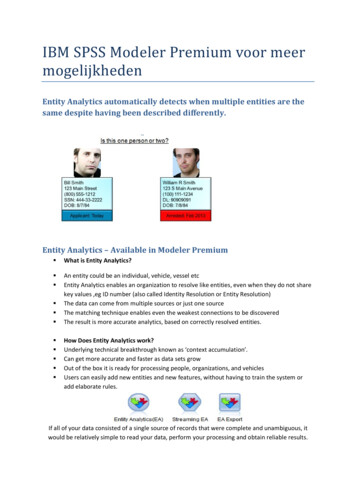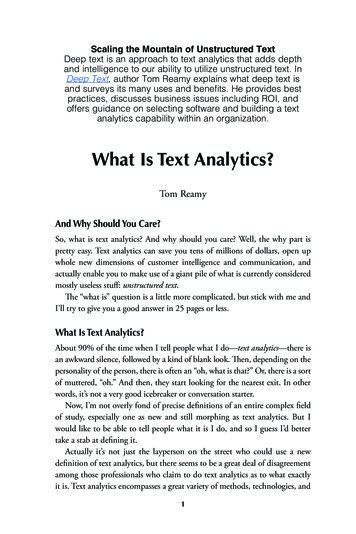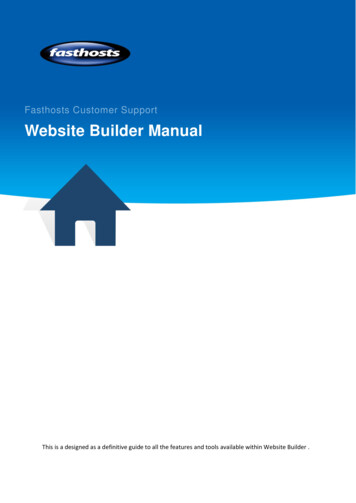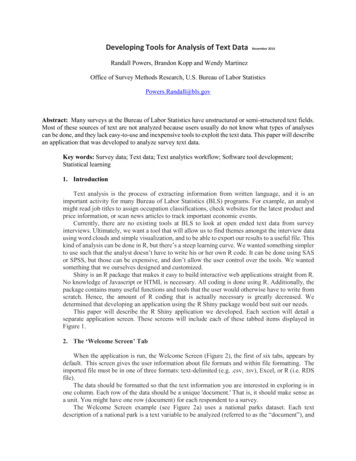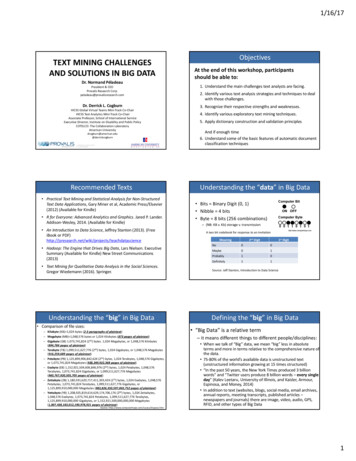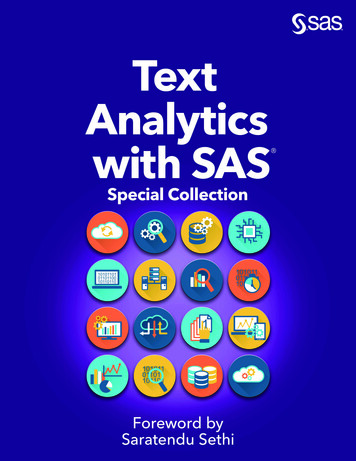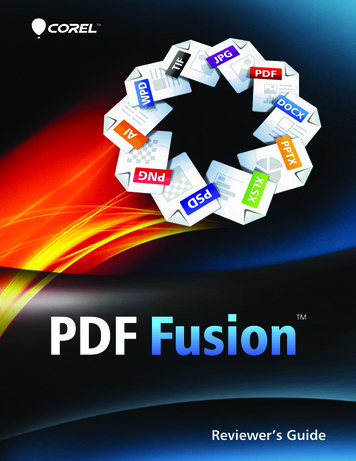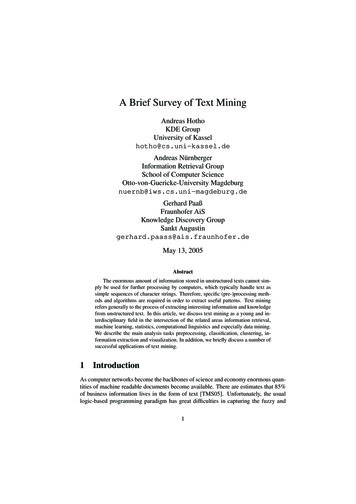
Transcription
A Brief Survey of Text MiningAndreas HothoKDE GroupUniversity of Kasselhotho@cs.uni-kassel.deAndreas NürnbergerInformation Retrieval GroupSchool of Computer ScienceOtto-von-Guericke-University Magdeburgnuernb@iws.cs.uni-magdeburg.deGerhard PaaßFraunhofer AiSKnowledge Discovery GroupSankt Augustingerhard.paass@ais.fraunhofer.deMay 13, 2005AbstractThe enormous amount of information stored in unstructured texts cannot simply be used for further processing by computers, which typically handle text assimple sequences of character strings. Therefore, specific (pre-)processing methods and algorithms are required in order to extract useful patterns. Text miningrefers generally to the process of extracting interesting information and knowledgefrom unstructured text. In this article, we discuss text mining as a young and interdisciplinary field in the intersection of the related areas information retrieval,machine learning, statistics, computational linguistics and especially data mining.We describe the main analysis tasks preprocessing, classification, clustering, information extraction and visualization. In addition, we briefly discuss a number ofsuccessful applications of text mining.1 IntroductionAs computer networks become the backbones of science and economy enormous quantities of machine readable documents become available. There are estimates that 85%of business information lives in the form of text [TMS05]. Unfortunately, the usuallogic-based programming paradigm has great difficulties in capturing the fuzzy and1
often ambiguous relations in text documents. Text mining aims at disclosing the concealed information by means of methods which on the one hand are able to cope withthe large number of words and structures in natural language and on the other handallow to handle vagueness, uncertainty and fuzziness.In this paper we describe text mining as a truly interdisciplinary method drawingon information retrieval, machine learning, statistics, computational linguistics and especially data mining. We first give a short sketch of these methods and then definetext mining in relation to them. Later sections survey state of the art approaches forthe main analysis tasks preprocessing, classification, clustering, information extractionand visualization. The last section exemplifies text mining in the context of a numberof successful applications.1.1 Knowledge DiscoveryIn literature we can find different definitions of the terms knowledge discovery orknowledge discovery in databases (KDD) and data mining. In order to distinguishdata mining from KDD we define KDD according to Fayyad as follows [FPSS96]:”Knowledge Discovery in Databases (KDD) is the non-trivial process ofidentifying valid, novel, potentially useful, and ultimately understandablepatterns in data”The analysis of data in KDD aims at finding hidden patterns and connections inthese data. By data we understand a quantity of facts, which can be, for instance, data ina database, but also data in a simple text file. Characteristics that can be used to measurethe quality of the patterns found in the data are the comprehensibility for humans,validity in the context of given statistic measures, novelty and usefulness. Furthermore,different methods are able to discover not only new patterns but to produce at the sametime generalized models which represent the found connections. In this context, theexpression “potentially useful” means that the samples to be found for an applicationgenerate a benefit for the user. Thus the definition couples knowledge discovery with aspecific application.Knowledge discovery in databases is a process that is defined by several processingsteps that have to be applied to a data set of interest in order to extract useful patterns.These steps have to be performed iteratively and several steps usually require interactive feedback from a user. As defined by the CRoss Industry Standard Process for DataMining (Crisp DM1 ) model [cri99] the main steps are: (1) business understanding2 , (2)data understanding, (3) data preparation, (4) modelling, (5) evaluation, (6) deployment(cf. fig. 13 ). Besides the initial problem of analyzing and understanding the overalltask (first two steps) one of the most time consuming steps is data preparation. Thisis especially of interest for text mining which needs special preprocessing methods to1 http://www.crisp-dm.org/2 Business understanding could be defined as understanding the problem we need to solve. In the contextof text mining, for example, that we are looking for groups of similar documents in a given documentcollection.3 figure is taken from http://www.crisp-dm.org/Process/index.htm2
Figure 1: Phases of Crisp DMconvert textual data into a format which is suitable for data mining algorithms. The application of data mining algorithms in the modelling step, the evaluation of the obtainedmodel and the deployment of the application (if necessary) are closing the process cycle. Here the modelling step is of main interest as text mining frequently requires thedevelopment of new or the adaptation of existing algorithms.1.2 Data Mining, Machine Learning and Statistical LearningResearch in the area of data mining and knowledge discovery is still in a state of greatflux. One indicator for this is the sometimes confusing use of terms. On the one sidethere is data mining as synonym for KDD, meaning that data mining contains all aspectsof the knowledge discovery process. This definition is in particular common in practiceand frequently leads to problems to distinguish the terms clearly. The second wayof looking at it considers data mining as part of the KDD-Processes (see [FPSS96])and describes the modelling phase, i.e. the application of algorithms and methods forthe calculation of the searched patterns or models. Other authors like for instanceKumar and Joshi [KJ03] consider data mining in addition as the search for valuableinformation in large quantities of data. In this article, we equate data mining with themodelling phase of the KDD process.The roots of data mining lie in most diverse areas of research, which underlines theinterdisciplinary character of this field. In the following we briefly discuss the relationsto three of the addressed research areas: Databases, machine learning and statistics.Databases are necessary in order to analyze large quantities of data efficiently. In3
this connection, a database represents not only the medium for consistent storing andaccessing, but moves in the closer interest of research, since the analysis of the datawith data mining algorithms can be supported by databases and thus the use of databasetechnology in the data mining process might be useful. An overview of data miningfrom the database perspective can be found in [CHY96].Machine Learning (ML) is an area of artificial intelligence concerned with the development of techniques which allow computers to ”learn” by the analysis of data sets.The focus of most machine learning methods is on symbolic data. ML is also concerned with the algorithmic complexity of computational implementations. Mitchellpresents many of the commonly used ML methods in [Mit97].Statistics has its grounds in mathematics and deals with the science and practice forthe analysis of empirical data. It is based on statistical theory which is a branch of applied mathematics. Within statistical theory, randomness and uncertainty are modelledby probability theory. Today many methods of statistics are used in the field of KDD.Good overviews are given in [HTF01, Be99, Mai02].1.3Definition of Text MiningText mining or knowledge discovery from text (KDT) — for the first time mentionedin Feldman et al. [FD95] — deals with the machine supported analysis of text. It usestechniques from information retrieval, information extraction as well as natural language processing (NLP) and connects them with the algorithms and methods of KDD,data mining, machine learning and statistics. Thus, one selects a similar procedure aswith the KDD process, whereby not data in general, but text documents are in focusof the analysis. From this, new questions for the used data mining methods arise. Oneproblem is that we now have to deal with problems of — from the data modellingperspective — unstructured data sets.If we try to define text mining, we can refer to related research areas. For eachof them, we can give a different definition of text mining, which is motivated by thespecific perspective of the area:Text Mining Information Extraction. The first approach assumes that text miningessentially corresponds to information extraction (cf. section 3.3) — the extraction of facts from texts.Text Mining Text Data Mining. Text mining can be also defined — similar to datamining — as the application of algorithms and methods from the fields machinelearning and statistics to texts with the goal of finding useful patterns. For thispurpose it is necessary to pre-process the texts accordingly. Many authors useinformation extraction methods, natural language processing or some simple preprocessing steps in order to extract data from texts. To the extracted data thendata mining algorithms can be applied (see [NM02, Gai03]).Text Mining KDD Process. Following the knowledge discovery process model [cri99],we frequently find in literature text mining as a process with a series of partialsteps, among other things also information extraction as well as the use of datamining or statistical procedures. Hearst summarizes this in [Hea99] in a general4
manner as the extraction of not yet discovered information in large collections oftexts. Also Kodratoff in [Kod99] and Gomez in [Hid02] consider text mining asprocess orientated approach on texts.In this article, we consider text mining mainly as text data mining. Thus, our focusis on methods that extract useful patterns from texts in order to, e.g., categorize orstructure text collections or to extract useful information.1.4 Related Research AreasCurrent research in the area of text mining tackles problems of text representation,classification, clustering, information extraction or the search for and modelling ofhidden patterns. In this context the selection of characteristics and also the influence ofdomain knowledge and domain-specific procedures plays an important role. Therefore,an adaptation of the known data mining algorithms to text data is usually necessary. Inorder to achieve this, one frequently relies on the experience and results of research ininformation retrieval, natural language processing and information extraction. In all ofthese areas we also apply data mining methods and statistics to handle their specifictasks:Information Retrieval (IR). Information retrieval is the finding of documents whichcontain answers to questions and not the finding of answers itself [Hea99]. In order toachieve this goal statistical measures and methods are used for the automatic processing of text data and comparison to the given question. Information retrieval in thebroader sense deals with the entire range of information processing, from data retrievalto knowledge retrieval (see [SJW97] for an overview). Although, information retrievalis a relatively old research area where first attempts for automatic indexing where madein 1975 [SWY75], it gained increased attention with the rise of the World Wide Weband the need for sophisticated search engines.Even though, the definition of information retrieval is based on the idea of questions and answers, systems that retrieve documents based on keywords, i.e. systemsthat perform document retrieval like most search engines, are frequently also calledinformation retrieval systems.Natural Language Processing (NLP). The general goal of NLP is to achieve a betterunderstanding of natural language by use of computers [Kod99]. Others include alsothe employment of simple and durable techniques for the fast processing of text, asthey are presented e.g. in [Abn91]. The range of the assigned techniques reaches fromthe simple manipulation of strings to the automatic processing of natural languageinquiries. In addition, linguistic analysis techniques are used among other things forthe processing of text.Information Extraction (IE). The goal of information extraction methods is the extraction of specific information from text documents. These are stored in data base-likepatterns (see [Wil97]) and are then available for further use. For further details seesection 3.3.5
In the following, we will frequently refer to the above mentioned related areas ofresearch. We will especially provide examples for the use of machine learning methodsin information extraction and information retrieval.2Text EncodingFor mining large document collections it is necessary to pre-process the text documentsand store the information in a data structure, which is more appropriate for further processing than a plain text file. Even though, meanwhile several methods exist that try toexploit also the syntactic structure and semantics of text, most text mining approachesare based on the idea that a text document can be represented by a set of words, i.e.a text document is described based on the set of words contained in it (bag-of-wordsrepresentation). However, in order to be able to define at least the importance of a wordwithin a given document, usually a vector representation is used, where for each word anumerical ”importance” value is stored. The currently predominant approaches basedon this idea are the vector space model [SWY75], the probabilistic model [Rob77] andthe logical model [van86].In the following we briefly describe, how a bag-of-words representation can beobtained. Furthermore, we describe the vector space model and corresponding similarity measures in more detail, since this model will be used by several text miningapproaches discussed in this article.2.1 Text PreprocessingIn order to obtain all words that are used in a given text, a tokenization process is required, i.e. a text document is split into a stream of words by removing all punctuationmarks and by replacing tabs and other non-text characters by single white spaces. Thistokenized representation is then used for further processing. The set of different wordsobtained by merging all text documents of a collection is called the dictionary of adocument collection.In order to allow a more formal description of the algorithms, we define first someterms and variables that will be frequently used in the following: Let D be the set ofdocuments and T {t1 , . . . , tm } be the dictionary, i.e. the set of all different termsoccurring in D, then the absolute frequency of term t T in document d D is givenby tf(d, t). We denote the term vectors t d (tf(d, t1 ), . . . , tf(d, tm )). Later on, we willalso need the notionP of the centroid of a set X of term vectors. It is defined as the mean1 value t X : X t d X td of its term vectors. In the sequel, we will apply tf also onP0subsets of terms: For T T, we let tf(d, T0 ) : t T0 tf(d, t).2.1.1Filtering, Lemmatization and StemmingIn order to reduce the size of the dictionary and thus the dimensionality of the description of documents within the collection, the set of words describing the documents canbe reduced by filtering and lemmatization or stemming methods.6
Filtering methods remove words from the dictionary and thus from the documents.A standard filtering method is stop word filtering. The idea of stop word filtering isto remove words that bear little or no content information, like articles, conjunctions,prepositions, etc. Furthermore, words that occur extremely often can be said to be oflittle information content to distinguish between documents, and also words that occurvery seldom are likely to be of no particular statistical relevance and can be removedfrom the dictionary [FBY92]. In order to further reduce the number of words in thedictionary, also (index) term selection methods can be used (see Sect. 2.1.2).Lemmatization methods try to map verb forms to the infinite tense and nouns tothe singular form. However, in order to achieve this, the word form has to be known,i.e. the part of speech of every word in the text document has to be assigned. Sincethis tagging process is usually quite time consuming and still error-prone, in practicefrequently stemming methods are applied.Stemming methods try to build the basic forms of words, i.e. strip the plural ’s’ fromnouns, the ’ing’ from verbs, or other affixes. A stem is a natural group of words withequal (or very similar) meaning. After the stemming process, every word is representedby its stem. A well-known rule based stemming algorithm has been originally proposedby Porter [Por80]. He defined a set of production rules to iteratively transform (English)words into their stems.2.1.2Index Term SelectionTo further decrease the number of words that should be used also indexing or keywordselection algorithms can be used (see, e.g. [DDFL90, WMB99]). In this case, only theselected keywords are used to describe the documents. A simple method for keywordselection is to extract keywords based on their entropy. E.g. for each word t in thevocabulary the entropy as defined by [LS89] can be computed:W (t) 1 1Xlog2 D d DP (d, t) log2 P (d, t) withtf(d, t)P (d, t) Pn(1)l 1 tf(dl , t)Here the entropy gives a measure how well a word is suited to separate documentsby keyword search. For instance, words that occur in many documents will have lowentropy. The entropy can be seen as a measure of the importance of a word in the givendomain context. As index words a number of words that have a high entropy relative totheir overall frequency can be chosen, i.e. of words occurring equally often those withthe higher entropy can be preferred.In order to obtain a fixed number of index terms that appropriately cover the documents, a simple greedy strategy can be applied: From the first document in the collection select the term with the highest relative entropy (or information gain as describedin Sect. 3.1.1) as an index term. Then mark this document and all other documents containing this term. From the first of the remaining unmarked documents select again theterm with the highest relative entropy as an index term. Then mark again this documentand all other documents containing this term. Repeat this process until all documentsare marked, then unmark them all and start again. The process can be terminated whenthe desired number of index terms have been selected. A more detailed discussion of7
the benefits of this approach for clustering - with respect to reduction of words requiredin order to obtain a good clustering performance - can be found in [BN04].An index term selection methods that is more appropriate if we have to learn aclassifier for documents is discussed in Sect. 3.1.1. This approach also considers theword distributions within the classes.2.2 The Vector Space ModelDespite of its simple data structure without using any explicit semantic information,the vector space model enables very efficient analysis of huge document collections. Itwas originally introduced for indexing and information retrieval [SWY75] but is nowused also in several text mining approaches as well as in most of the currently availabledocument retrieval systems.The vector space model represents documents as vectors in m-dimensional space,i.e. each document d is described by a numerical feature vector w(d) (x(d, t1 ), . . . , x(d, tm )).Thus, documents can be compared by use of simple vector operations and even queriescan be performed by encoding the query terms similar to the documents in a queryvector. The query vector can then be compared to each document and a result list canbe obtained by ordering the documents according to the computed similarity [SAB94].The main task of the vector space representation of documents is to find an appropriateencoding of the feature vector.Each element of the vector usually represents a word (or a group of words) of thedocument collection, i.e. the size of the vector is defined by the number of words (orgroups of words) of the complete document collection. The simplest way of documentencoding is to use binary term vectors, i.e. a vector element is set to one if the corresponding word is used in the document and to zero if the word is not. This encodingwill result in a simple Boolean comparison or search if a query is encoded in a vector.Using Boolean encoding the importance of all terms for a specific query or comparisonis considered as similar. To improve the performance usually term weighting schemesare used, where the weights reflect the importance of a word in a specific document ofthe considered collection. Large weights are assigned to terms that are used frequentlyin relevant documents but rarely in the whole document collection [SB88]. Thus aweight w(d, t) for a term t in document d is computed by term frequency tf(d, t) timesinverse document frequency idf(t), which describes the term specificity within the document collection. In [SAB94] a weighting scheme was proposed that has meanwhileproven its usability in practice. Besides term frequency and inverse document frequency — defined as idf (t) : log(N/nt ) —, a length normalization factor is used toensure that all documents have equal chances of being retrieved independent of theirlengths:w(d, t) qPmtf(d, t) log(N/nt )22j 1 tf (d, tj ) (log(N/ntj )),(2)where N is the size of the document collection D and nt is the number of documentsin D that contain term t.8
Based on a weighting scheme a document d is defined by a vector of term weightsw(d) (w(d, t1 ), . . . , w(d, tm )) and the similarity S of two documents d1 and d2(or the similarity of a document and a query vector) can be computed based on theinner product of the vectors (by which – if we assume normalized vectors – the cosinebetween the two document vectors is computed), i.e.XmS(d1 , d2 ) w(d1 , tk ) · w(d2 , tk ).(3)k 1A frequently used distance measure is the Euclidian distance. We calculate thedistance between two text documents d1 , d2 D as follows:rXm2dist(d1 , d2 ) 2 w(d1 , tk ) w(d2 , tk ) .(4)k 1However, the Euclidean distance should only be used for normalized vectors, sinceotherwise the different lengths of documents can result in a smaller distance betweendocuments that share less words than between documents that have more words incommon and should be considered therefore as more similar.Note that for normalized vectors the scalar product is not much different in behaviorfrom the Euclidean distance, since for two vectors x and y it isµ¶ x y1 x ycos ϕ 1 d2,. x · y 2 x y For a more detailed discussion of the vector space model and weighting schemessee, e.g. [BYRN99, Gre98, SB88, SWY75].2.3 Linguistic PreprocessingOften text mining methods may be applied without further preprocessing. Sometimes,however, additional linguistic preprocessing (c.f. [MS01a]) may be used to enhance theavailable information about terms. For this, the following approaches are frequentlyapplied:Part-of-speech tagging (POS) determines the part of speech tag, e.g. noun, verb,adjective, etc. for each term.Text chunking aims at grouping adjacent words in a sentence. An example of a chunkis the noun phrase “the current account deficit”.Word Sense Disambiguation (WSD) tries to resolve the ambiguity in the meaning ofsingle words or phrases. An example is ‘bank’ which may have – among others –the senses ‘financial institution’ or the ‘border of a river or lake’. Thus, instead ofterms the specific meanings could be stored in the vector space representation.This leads to a bigger dictionary but considers the semantic of a term in therepresentation.Parsing produces a full parse tree of a sentence. From the parse, we can find therelation of each word in the sentence to all the others, and typically also itsfunction in the sentence (e.g. subject, object, etc.).9
Linguistic processing either uses lexica and other resources as well as hand-craftedrules. If a set of examples is available machine learning methods as described in section3, especially in section 3.3, may be employed to learn the desired tags.It turned out, however, that for many text mining tasks linguistic preprocessing is oflimited value compared to the simple bag-of-words approach with basic preprocessing.The reason is that the co-occurrence of terms in the vector representation serves asan automatic disambiguation, e.g. for classification [LK02]. Recently some progresswas made by enhancing bag of words with linguistic feature for text clustering andclassification [HSS03, BH04].3Data Mining Methods for TextOne main reason for applying data mining methods to text document collections is tostructure them. A structure can significantly simplify the access to a document collection for a user. Well known access structures are library catalogues or book indexes.However, the problem of manual designed indexes is the time required to maintainthem. Therefore, they are very often not up-to-date and thus not usable for recent publications or frequently changing information sources like the World Wide Web. Theexisting methods for structuring collections either try to assign keywords to documentsbased on a given keyword set (classification or categorization methods) or automatically structure document collections to find groups of similar documents (clusteringmethods). In the following we first describe both of these approaches. Furthermore,we discuss in Sect. 3.3 methods to automatically extract useful information patternsfrom text document collections. In Sect. 3.4 we review methods for visual text mining. These methods allow in combination with structuring methods the developmentof powerful tools for the interactive exploration of document collections. We concludethis section with a brief discussion of further application areas for text mining.3.1 ClassificationText classification aims at assigning pre-defined classes to text documents [Mit97]. Anexample would be to automatically label each incoming news story with a topic like”sports”, ”politics”, or ”art”. Whatever the specific method employed, a data miningclassification task starts with a training set D (d1 , . . . , dn ) of documents that arealready labelled with a class L L (e.g. sport, politics). The task is then to determinea classification modelf :D Lf (d) L(5)which is able to assign the correct class to a new document d of the domain.To measure the performance of a classification model a random fraction of the labelled documents is set aside and not used for training. We may classify the documentsof this test set with the classification model and compare the estimated labels withthe true labels. The fraction of correctly classified documents in relation to the totalnumber of documents is called accuracy and is a first performance measure.Often, however, the target class covers only a small percentage of the documents.Then we get a high accuracy if we assign each document to the alternative class. To10
avoid this effect different measures of classification success are often used. Precisionquantifies the fraction of retrieved documents that are in fact relevant, i.e. belong to thetarget class. Recall indicates which fraction of the relevant documents is retrieved.precision #{relevant retrieved}#retrievedrecall #{relevant retrieved}#relevant(6)Obviously there is a trade off between precision and recall. Most classifiers internally determine some “degree of membership” in the target class. If only documents ofhigh degree are assigned to the target class, the precision is high. However, many relevant documents might have been overlooked, which corresponds to a low recall. Whenon the other hand the search is more exhaustive, recall increases and precision goesdown. The F-score is a compromise of both for measuring the overall performance ofclassifiers.2F (7)1/recall 1/precision3.1.1Index Term SelectionAs document collections often contain more than 100000 different words we may selectthe most informative ones for a specific classification task to reduce the number ofwords and thus the complexity of the classification problem at hand. One commonlyused ranking score is the information gain which for a term tj is defined as2X12XX11 p(tj m)p(Lc tj m) log2p(L)p(L tcc j m)c 1m 0c 1(8)Here p(Lc ) is the fraction of training documents with classes L1 and L2 , p(tj 1) andp(tj 0) is the number of documents with / without term tj and p(Lc tj m) is theconditional probability of classes L1 and L2 if term tj is contained in the document oris missing. It measures how useful tj is for predicting L1 from an information-theoreticpoint of view. We may determine IG(tj ) for all terms and remove those with very lowinformation gain from the dictionary.In the following sections we describe the most frequently used data mining methodsfor text categorization.IG(tj ) 3.1.2p(Lc ) log2Naı̈ve Bayes ClassifierProbabilistic classifiers start with the assumption that the words of a document di havebeen generated by a probabilistic mechanism. It is supposed that the class L(di ) ofdocument di has some relation to the words which appear in the document. This maybe described by the conditional distribution p(t1 , . . . , tni L(di )) of the ni words giventhe class. Then the Bayesian formula yields the probability of a class given the wordsof a document [Mit97]p(t1 , . . . , tni Lc )p(Lc )p(Lc t1 , . . . , tni ) PL L p(t1 , . . . , tni L)p(L)11
Note that each document is assumed to belong to exactly one of the k classes in L.The prior probability p(L) denotes the probability that an arbitrary document belongsto class L before its words are known. Often the prior probabilities of all classes maybe taken to be equal. The conditional probability on the left is the desired posteriorprobability that the document with words t1 , . .
tive feedback from a user. As defined by the CRoss Industry Standard Process for Data Mining (Crisp DM1) model [cri99] the main steps are: (1) business understanding2, (2) data understanding, (3) data preparation, (4) modelling, (5) evaluation, (6) deployment (cf. fig. 1 3). Besides the initial problem of analyzing and understanding the overall
